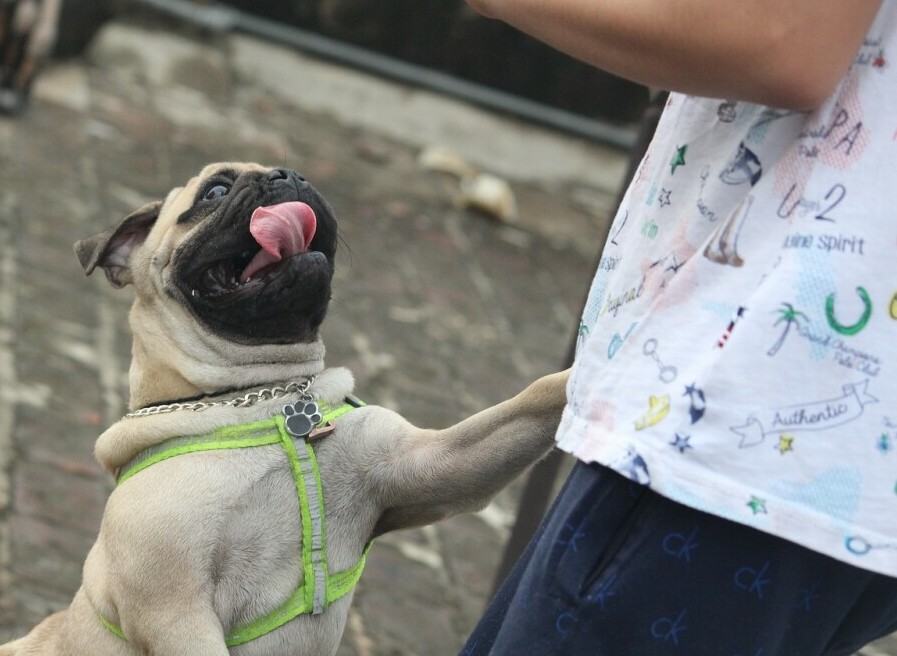
A few of the links in this post are affiliate links. If you buy something, we may earn a small commission (no extra bones from your wallet 🐾). Thanks for helping support the site and all of the dog adventures!
Does your dog like to jump on people? You’re not alone. Many dog owners face this exuberant greeting behavior that, while often a sign of affection, can be problematic.
We’re going to explore why dogs jump up in the first place, so you can better understand what’s going on in your furry friend’s head when their paws leave the ground. This is your go to guide on how to stop your dog from jumping up.
Firstly, dogs jump on people for a few common reasons. They might be trying to get your attention, they could be excited, or they just want to say hello. Sometimes, it’s simply because they’ve learned that jumping up gets them the interaction they’re craving.
Identifying what triggers your dog’s jumping is an essential first step. Observe them closely – are they jumping when you come home, when they’re hungry, or when they see a leash in your hands?
Understanding your dog’s body language is the next piece of the puzzle. A wagging tail and playful demeanor usually accompany jumping when they’re happy to see you.
On the flip side, if their ears are pinned back and they seem tense, it might indicate anxiety or overexcitement. Don’t worry too much about it – every dog’s different, and with a bit of observation, you’ll start to decode your dog’s unique signals.
Finally, it’s all about empathy. Put yourself in your dog’s paws. Their world is so different from ours. To a dog, jumping up can be a natural way to greet and interact, especially when they’re at a height disadvantage.
By understanding their perspective, we can approach training with kindness and effectiveness. Ultimately, no matter the cause behind the jumping, in order to train your pup to stop you will need patience and love.
Jumping up is one of the most common behavior issues. Get practical solutions in Common Dog Behavior Problems and How to Fix Them.

Effective Strategies to Discourage Jumping
If you’re faced with a canine companion that greets everyone with more bounce than you’d like, you’re going to find out about some effective strategies that can help change this habit. It’s all about timing, consistency, and positive reinforcement.
First off, choose something that resonates with you and your dog when it comes to training methods. Some owners find that turning their back and ignoring the dog when it jumps helps to convey the message that jumping doesn’t get attention. We’re here to help you understand that any attention, even negative, could reinforce the behavior.
Always reward good behavior. When your dog keeps all four paws on the floor, shower them with praise, treats, or their favorite toy. This is positive reinforcement in action, showing your dog that not jumping is in their best interest.
Your commands need to be clear and consistent. Teach phrases like ‘sit’ or ‘down’ to use every time someone enters your home. Consistency is key here, so everyone in your household should respond the same way every time your dog jumps. For a full list of dog commands to teach your pup, click here.
Finally, don’t worry too much about setbacks. Training a dog not to jump can take time, so be patient and keep at it. We can assure you, with a healthy dose of warmth and consistent effort, your dog will start greeting guests without knocking them over.
In our opinion, just seeing the positive changes in your dog’s behavior is incredibly rewarding. That said, it’s time to delve into specific training techniques to turn these strategies into action, which is precisely what the next section is all about.
As with all training you need to be consistent and patient, and after awhile you will have a dog that won’t bug your house guests when they come to the door.
Leash manners and polite greetings go hand in hand. Learn both in How to Stop Dog from Pulling Leash.

Training Techniques to Keep Your Dog Grounded
So you’re ready to train your dog not to jump up on people? Great, you’ve already taken the first step by acknowledging the need for training. We’re here to help you with a step-by-step guide that’s going to be your blueprint for success.
Creating a calm environment is critical when you start training. Dogs are sensitive to our emotions and can become excited or nervous based on our behavior. Speak in soothing tones and keep your energy levels in check. This helps set the tone for a focused training session.
Socialization plays a pivotal role in preventing jumping. Expose your dog to different people and settings so they learn the appropriate ways to interact. It’s vital to do this regularly and reward your dog for keeping all four paws on the ground.
This is important because it’s tough to consistently nail this training if your dog doesn’t have anyone to practice on. Ask for the help of a friend or relative so your dog gets used to dealing with people other than it’s owners. New faces will help reinforce this training so that they know not to jump on people coming to the house.
Don’t forget about boundaries. They can be your best friend in this training journey. Use gates or pens if needed to manage your dog’s space.
This can prevent jumping while you’re working on commands and can be a great way to gradually introduce guests without overwhelming your pup. Sometimes it’s nice to have a boundary to practice with so that your dog will understand when to stop.
Remember, training isn’t an overnight thing. Give yourself and your dog grace as you adjust to this new routine. If you stick with it, you’re going to see some amazing progress. Let’s get into building good habits for your dog when guests arrive.
Dogs that lack impulse control may jump, steal, or grab objects. Find solutions in How to Stop Dog from Stealing Things.
Looking for fresh dog food delivered? Click here.

Maintaining Good Habits and Wrapping Up
You’ve put in the effort, followed the steps, and now you’re seeing progress in curbing your dog’s urge to jump. That’s no small feat, so give yourself—and your pup—a well-deserved pat on the back! But, don’t let this be the end of your journey.
Remember, maintaining good behaviors is an ongoing process. Dogs are creatures of habit, and just like us, they can slip up if not provided with consistent reinforcement.
To ensure the longevity of your dog’s polite greetings, continue to practice the training exercises occasionally, and most importantly, always acknowledge and reward good behavior.
Additionally, make sure your furry friend gets plenty of exercise because a tired dog is a well-behaved dog. Regular walks, playtime, and mental stimulation can greatly diminish the pent-up energy that often leads to undesirable behaviors like jumping.
All in all, your goal is a happy, sociable dog who knows how to express excitement in ways that are safe and enjoyable for everyone.
Keep working together, celebrate every success along the way, and don’t get discouraged by the occasional hiccup. With patience and dedication, you and your dog will continue to grow and learn from each other.
We really hope that you’ve found these insights helpful for stopping your dog from jumping up. Training your dog requires time and patience, but the bond it creates and the positive behaviors it instills are absolutely worth it. Stick with it, and soon, those jumpy greetings will be a thing of the past!
Recognizing overexcitement signals helps prevent jumping. Dive deeper in The Science Behind Canine Body Language and How to Read It.

